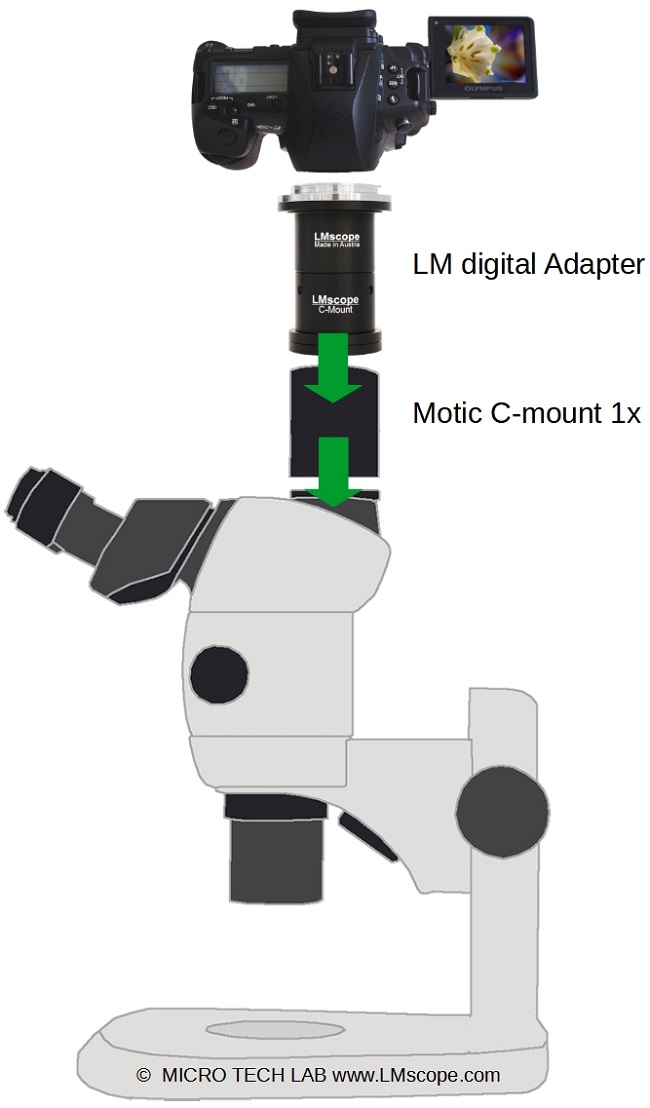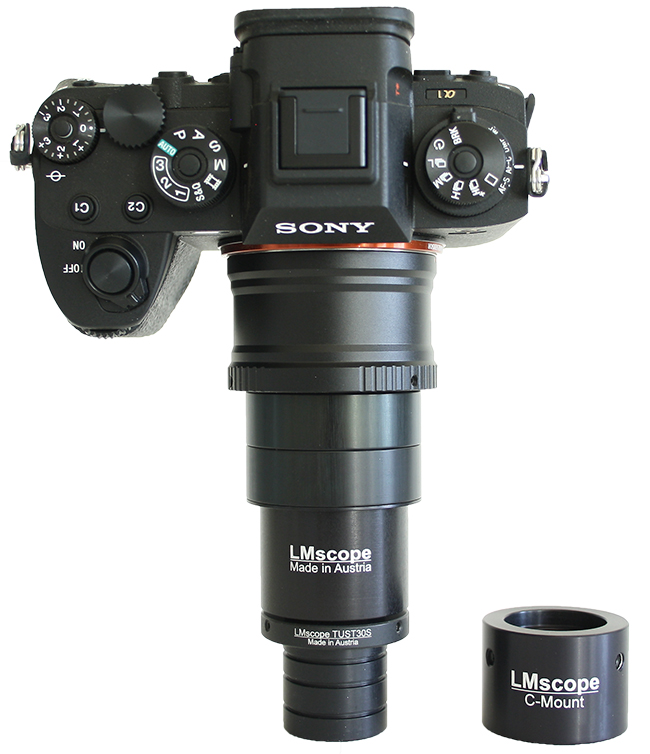

Using the Motic SM7 stereo microscope for digital photomicrography
The Motic SM7 stereo microscope was launched in 2020 and features a Galilean optical system based on the working principle of the telescope. Combined with a high-quality plan apo objective, it is a very interesting option for photomicroscopy.
With our LM adapter systems, high-quality modern mirrorless system cameras, DSLRs and also C-mount cameras can be stably attached to the Motic SM7.
Unlike Greenough stereo microscopes, microscopes of the Galilean type are infinity corrected. They only have one single large objective lens which is shared by both optical paths (left and right eye). The observer’s brain fuses the two images viewed simultaneously with each eye into a three-dimensional image with high depth of field. Microscopes featuring this design are a much better choice for photomicrography than Greenough-type microscopes.
Key features of the Motic SM7:
- Zoom stereo microscope with zoom ratio 7:1, 0.8x to 5.6x
- Galileian infinity optical system with common main objective (CMO) design
- Plan achromat or plan apochromat objective lenses
- Long working distance (distance between front lens and specimen)
- LED transmitted & reflected illumination, 3W
- Trinocular head with C-mount 1x connector available (Motic product code 1101.0117.00201)
- Well suited for digital photomicrography
The quality of the objective plays a particularly important role. Both plan achromats and the higher-quality plan apochromats (1x) are available for the SM7. Objective lenses with a plan apochromatic design provide an image that is almost entirely free from chromatic aberrations.
The SM7 is available with a binocular or trinocular viewing head and is designed for users in the fields of biology, medicine and industry. For the trinocular tube (with a beam split of 80% trinocular/20% eyepieces), a C-mount 1x connector is available (Motic product code 1101.0117.00201). This head is ideal for using our LM adapter solutions with plan achromatic precision optics.

With a 7:1 zoom ratio, the SM7 achieves magnification ranges from 4x to 112x, depending on the lenses used and the microscope’s eyepieces.
Working distance (depending on the objective lens)
| Objective | Working distance [mm] |
|---|---|
| ACH 1X (Standard Objektiv) | 90mm |
| PLAPO 1X | 81mm |
| ACH 0.5X | 198.5mm |
| ACH 2X | 33.5mm |
The long working distance with standard 1x objectives is particularly advantageous for applications where manual work is required. However, the larger the working distance, the lower the resolution, which in turn impacts the image quality to a certain extent. To maximise resolution at higher magnification levels, we therefore recommend the stronger ACH 2X objective.
For photography through the microscope we generally recommend digital mirrorless system cameras or SLR cameras with large sensors. Due to the excellent quality of the image sensors on these cameras (high dynamic range and light sensitivity, fast shutter speed), they deliver considerably better image quality than cameras with small sensors (C-mount microscope cameras). Especially at lower magnifications, a large, high-quality sensor is definitely an advantage when it comes to making even the smallest details clearly visible in the photograph. More information and useful tips can be found in our camera recommendations and our camera ranking.

The SM7 stereo microscope has 3W LEDs for both types of illumination (transmitted and reflected light), which can be controlled separately. In photomicroscopy, illumination is a key factor. Flexible light sources help to avoid shadows when taking images. A good way to provide shadow-free illumination is to use gooseneck LED spotlights. For the SM7, an LED ring light is also available as an alternative.
Our “Pro” series LM widefield adapters also accommodate additional optical filters, which means that the Motic SM7 can be upgraded to a polarising microscope, for example. This opens up a whole new field of possibilities for the user.
LM microscope adapters have been developed to meet the most demanding requirements of professional imaging applications and get the maximum image quality out of both microscope and camera.
Adapter features of the “Pro” series microscope adapters:
- Widefield optics for maximum field of view without peripheral darkening
- Precision optics for superior resolution and light gathering power
- Focusable to enable an optical alignment of the eyepiece image with that of the phototube
- Modular design facilitating maximum flexibility
- Option of adding optical filters

Image: Sony A1 mirrorless system camera with adapter solution for eyepiece tube and C-mount connection
Conclusion: The Motic SM7 microscope is very well built, delivers superior image quality and, combined with our LM microscope adapters, is ideally suited for photomicroscopy. If you’re looking for a more budget-friendly alternative, take a closer look at its little brother, the SMZ 171.
28.06.2022Photography:
Fitting the microscope to digital single-lens reflex (DSLR), mirrorless interchangeable-lens cameras (MILC ), digital single-lens mirrorless (DSLM) or C-mount cameras is easy with our LM digital SLR adapters, which feature a plan achromatic optical system. Our products make it possible to capture top-quality microscope images. To help you select the adapter that is right for your camera, we have set up an online configurator on our website. You can also email us – ideally with attached photographs of your microscope.
Modern DSLR and single-lens mirrorless (DSLM) offer the latest technology and are generally very well suited for microscopy applications. Most of them can be controlled remotely via PC/Mac. Because of their high sales volumes, they offer an excellent price/performance ratio compared to special-purpose microscope cameras.
Features of top DSLR and single-lens mirrorless cameras (DSLM):
- Large, powerful full-frame sensors (36 x 24 mm)
- Sensor resolution of 61 megapixels or 240 megapixels with Pixel Shift technology
- High light sensitivity (ISO 400,000+)
- Extensive dynamic range (up to 15 aperture stops/f-stops)
- Short exposure times (1/8000 second) up to 1/32,000 seconds using the digital shutter
- 4K Ultra HD or 8K Ultra HD video function
- Live video capture on external monitors in ultra HD quality
In most cases, these cameras are significantly more powerful than microscope cameras with smaller sensors (1/2" or 2/3"). On our website you will find our current camera recommendations and a camera ranking which is specifically tailored to microscopy applications.